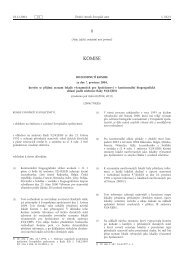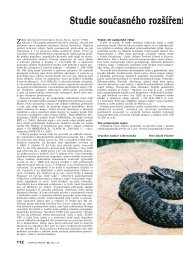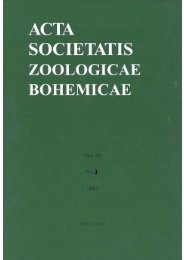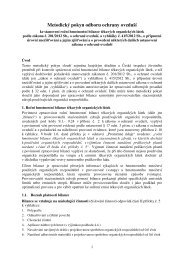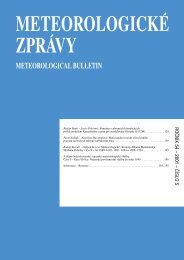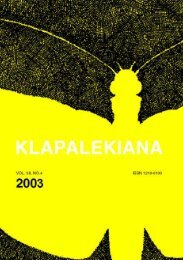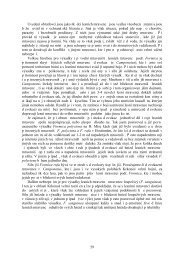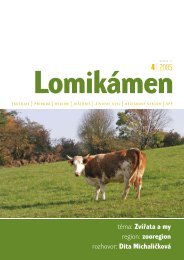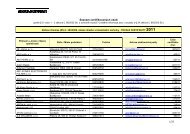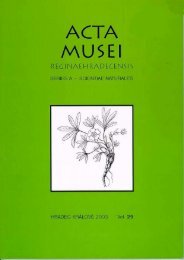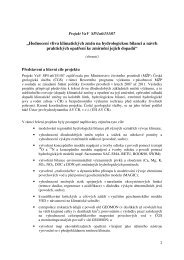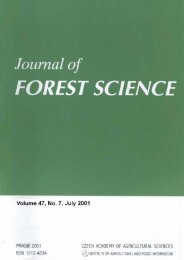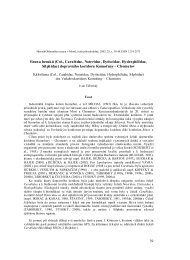Distribution and taxonomy of some Synapsis species, with ...
Distribution and taxonomy of some Synapsis species, with ...
Distribution and taxonomy of some Synapsis species, with ...
You also want an ePaper? Increase the reach of your titles
YUMPU automatically turns print PDFs into web optimized ePapers that Google loves.
velutina Portevin, 1943 / Jan R%ži!ka design. 2002 [p, red label] // Aclypea / daurica (Gebler, 1932) / Jan R%ži!ka<br />
det. 2002 [p]”; other material: 1 male, 2 females (NMPC), labelled “Inn Shan / Mongolei [p]”.<br />
COMMENTS. Aclypea daurica is known from Eastern Siberia to Far East <strong>of</strong> Russia, China <strong>and</strong> Korea<br />
(Cho & Lee 1992, Schawaller 1996).<br />
Portevin (1943) described Blitophaga velutina from “Mongolie: Iun Sthan”, printed locality<br />
labels bears also “Inn Shan”. According to Schütze & Kleinfeld (1997), this locality is In Shan<br />
north <strong>of</strong> Baotou, a part <strong>of</strong> Yin Shan mountains in China: Nei Mongol autonomous region. Portevin<br />
(1943) described this <strong>species</strong> based on an unknown number <strong>of</strong> specimens, <strong>and</strong> differs from similar<br />
Aclypea daurica (treated as Blitophaga daurica in Portevin 1943) by larger body size, long<br />
yellowish pubescence <strong>of</strong> upper surface <strong>and</strong> sparser <strong>and</strong> more superficial punctation <strong>of</strong> elytra. In<br />
the same paper, Portevin (1943) included a note, concerning the identity <strong>of</strong> A. daurica <strong>and</strong> mentioned<br />
that he studied two syntypes from coll. Mniszech, <strong>and</strong> that the description <strong>of</strong> this <strong>species</strong><br />
in his previous revision (Portevin 1926) was that <strong>of</strong> his newly described Blitophaga velutina.<br />
Schawaller (1996) did not study types <strong>of</strong> B. velutina <strong>and</strong> only noted (on p. 9) the possible synonymy<br />
<strong>of</strong> this <strong>species</strong> <strong>with</strong> Aclypea opaca (Linnaeus, 1758).<br />
I have studied two syntypes <strong>of</strong> Aclypea daurica (probably those mentioned by Portevin 1943),<br />
the specimen bearing the locality label is designated here as a lectotype, the second specimen as<br />
a paralectotype. Further, I have examined a series <strong>of</strong> syntype specimens <strong>of</strong> Blitophaga velutina,<br />
the first specimen bearing Portevin’s original determination label is designated here as a lectotype,<br />
the remaining ten specimens as paralectotypes. Further, syntopic specimens (bearing identical<br />
printed locality labels as the lectotype <strong>and</strong> two <strong>of</strong> the paralectotypes) probably not belonging to<br />
the original syntype series were found also in NMPC. Types <strong>of</strong> Aclypea daurica are identical in my<br />
opinion <strong>with</strong> Blitophaga velutina, having similar habitus <strong>and</strong> bearing four glabrous spots on<br />
pronotum <strong>and</strong> similar punctation <strong>of</strong> elytra. All specimens <strong>of</strong> B. velutina are covered dorsally <strong>with</strong><br />
dense, recumbent, yellow setation; which is sparser <strong>and</strong> dark brown in both types <strong>of</strong> Aclypea<br />
daurica. In my opinion, these changes have been caused by h<strong>and</strong>ling both these very old specimens,<br />
further specimens <strong>of</strong> A. daurica studied from Far East <strong>of</strong> Russia, Korea <strong>and</strong> China from<br />
JRUC, JSCC, MNHN <strong>and</strong> NMPC have dorsum covered <strong>with</strong> dense, yellow setation similar to that<br />
<strong>of</strong> the types <strong>of</strong> Blitophaga velutina. These differences, which reflect in my opinion only different<br />
h<strong>and</strong>ling <strong>of</strong> the material, probably led Portevin (1943) to describe B. velutina.<br />
Consequently, I consider Blitophaga velutina Portevin, 1943 as a junior subjective synonym <strong>of</strong><br />
Aclypea daurica (Gebler, 1832).<br />
Aclypea opaca (Linnaeus, 1758)<br />
Silpha opaca Linnaeus, 1758: 361.<br />
Silpha hirta Herbst, 1783: 34.<br />
Blitophaga opaca var. samnitica Fiori, 1899: 161; syn. n.<br />
TYPE MATERIAL EXAMINED. LT male <strong>of</strong> Blitophaga opaca var. samnitica (ZMHB; here designated), labelled “ABRUZZO<br />
[p] / G. Sasso / VII. [18]94 [hw] / A. FIORI [p, label <strong>with</strong> black frame] // Blitophaga / v. samnitica [hw] //<br />
LECTOTYPE (male symbol) / Blitophaga opaca / var. samnitica Fiori, 1899 // Jan R%ži!ka design. 2002 [p, red<br />
label] // Aclypea / opaca / (Linnaeus, 1758) / Jan R%ži!ka det. 2002 [p]”; PLT female (ZMHB), labelled “ABRUZZO<br />
[p] / G. Sasso / VII. [18]94 [hw] / A. FIORI [p, label <strong>with</strong> black frame] // PARALECTOTYPE (female symbol) /<br />
Blitophaga opaca / var. samnitica Fiori, 1899 // Jan R%ži!ka design. 2002 [p, red label] // Aclypea / opaca /<br />
(Linnaeus, 1758) / Jan R%ži!ka det. 2002 [p]”; PLT female (ZMHB), labelled “ABRUZZO / GRAN SASSO / LUG.<br />
[18]9 [p] 6 [hw] / A. FIORI [p, label <strong>with</strong> black frame] // PARALECTOTYPE (female symbol) / Blitophaga opaca<br />
/ var. samnitica Fiori, 1899 // Jan R%ži!ka design. 2002 [p, red label] // Aclypea / opaca / (Linnaeus, 1758) / Jan<br />
R%ži!ka det. 2002 [p]”.<br />
305



